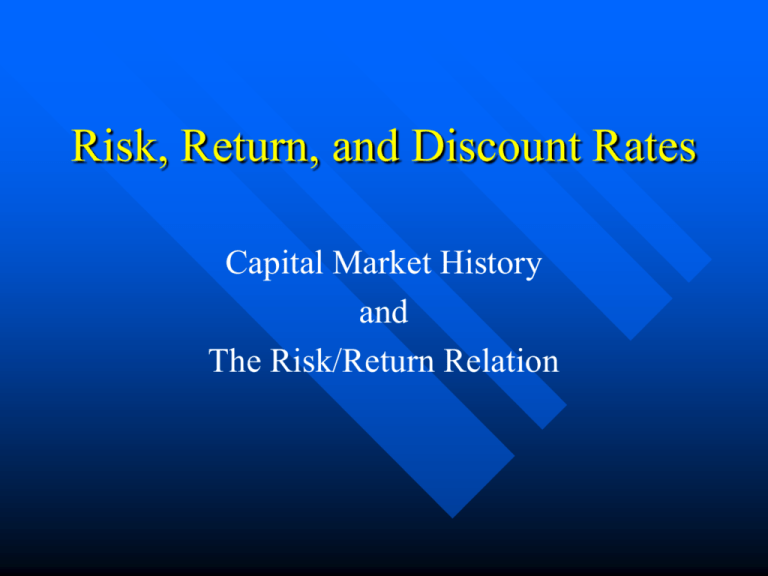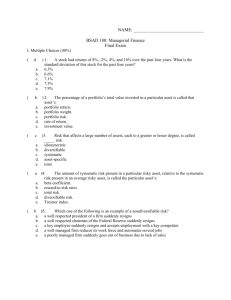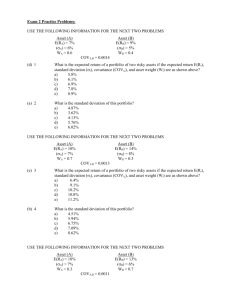
Risk, Return, and Discount Rates
Capital Market History
and
The Risk/Return Relation
How Are Risk and Expected
Return Related?
There are two main reasons to be concerned
with this question.
(1) When conducting discounted cash flow analysis, how
should we adjust discount rates to allow for risk in the
future cash flow stream?
(2) When saving/investing, what is the tradeoff between
taking risks and our expected future wealth?
Here we concentrate on the first of these questions. We will
however develop the answer to the first question by asking
the second. They are opposite sides of the same coin.
Discounting Risky Cash Flows
How must the discount rate change in our standard
NPV calculation if the cash flows are not riskless?
– This is more easily answered from the “other side.”
What must be the expected return on a risky asset so
you are happy to own it rather than a riskless asset?
– Risk averse investors say that to hold a risky asset they
require a higher expected return than they require for
holding a riskless asset. E(rrisky) = rf + .
» Note now that we have to start to talk about expected returns
since risk is being explicitly examined.
– Since a “comparable alternative” to a risky project is
owning a risky security the discount rate must also rise.
How does the expected return on a risky asset relate to the
risk of that asset? It is easy to see that expected return
should increase with the amount risk.
Expected
Return
Risk
But, how should risk be measured?
At what rate does the line slope up? At what level does it start?
Is it even a line?
Lets look at some simple but important historical evidence.
The Future Value of an Investment
of $1 in 1926
$1 (1 r1926 ) (1 r1927 ) (1 r1999 ) $2,845.63
1000
$40.22
$15.64
10
Common Stocks
Long T-Bonds
T-Bills
0.1
1930
1940
1950
1960
1970
1980
1990
2000
Source: © Stocks, Bonds, Bills, and Inflation 2000 Yearbook™, Ibbotson Associates, Inc., Chicago (annually updates work by
Roger G. Ibbotson and Rex A. Sinquefield). All rights reserved.
Rates of Return 1926-1999
60
40
20
0
-20
Common Stocks
Long T-Bonds
T-Bills
-40
-60 26
30
35
40
45
50
55
60
65
70
75
80
85
90
95
Source: © Stocks, Bonds, Bills, and Inflation 2000 Yearbook™, Ibbotson Associates, Inc., Chicago (annually updates work by
Roger G. Ibbotson and Rex A. Sinquefield). All rights reserved.
Risk, More Formally
Many people think intuitively about risk as the possibility
of an outcome that is worse than what one expected.
Useful but limited, if things can be worse they can also be
better than expected. Risk is the possibility of an outcome
being different than expected.
– For those who hold more than one asset, is it the risk of
each asset they care about, or the total risk of their
entire portfolio?
The standard construct for thinking rigorously about risk:
– The “probability distribution.”
– A list of all possible outcomes and their probabilities.
Example: Two Probability Distributions
on Tomorrow's Share Price.
Which implies more risk?
0.6
0.5
0.4
0.3
0.2
0.1
0
0.4
0.3
0.2
0.1
0
10 12 13 14 16
10 12 13 14 16
Risk and Probability Distributions
In very simple cases, we specify the probability
distributions completely.
Most often, we use parameters of the historical
distribution to summarize important information.
The expected value, which is the center or
mean of the distribution. When we think of
returns as random this is expected return.
The variance or standard deviation, which
measure the dispersion of possible outcomes
around the mean. We noted this captures risk.
Historical Returns, 1926-1999
Series
Average
Annual Return
Standard
Deviation
Large Company Stocks
13.0%
20.3%
Small Company Stocks
17.7
33.9
Long-Term Corporate Bonds
6.1
8.7
Long-Term Government Bonds
5.6
9.2
U.S. Treasury Bills
3.8
3.2
Inflation
3.2
4.5
– 90%
Distribution
0%
+ 90%
Source: © Stocks, Bonds, Bills, and Inflation 2000 Yearbook™, Ibbotson Associates, Inc., Chicago (annually updates work by
Roger G. Ibbotson and Rex A. Sinquefield). All rights reserved.
The Risk-Return Tradeoff
18%
Small-Company Stocks
Annual Return Average
16%
14%
Large-Company Stocks
12%
10%
8%
6%
T-Bonds
4%
T-Bills
2%
0%
5%
10%
15%
20%
25%
Annual Return Standard Deviation
30%
35%
Summary
An old saying on Wall Street is “You can either
sleep well or eat well.”
More than being simply colorful the idea is to
constantly remind people that greater reward
(expected reward) comes only with exposure to
greater risk.
The “other side” of the question then suggests that
for projects with risky cash flows the appropriate
discount rate must be higher than that for a project
with risk free cash flows.
The Capital Asset Pricing Model
The Risk Return Relation Formalized
Summary
E(r) = rf + .
= amount of risk premium per unit risk.
Defined the “market portfolio” as having one unit
of risk; Var(rm) = 1 “unit of risk.”
Risk premium per unit of risk is then E(rm) – rf.
Diversification implies that an asset’s contribution
to the risk of a large portfolio is measured not by
Var(ri) or STD (ri) but Cov(ri, rm).
Standardize Cov(ri, rm) by Var(rm) (to get it as the
number of “units”) and get i as the measure of
risk of any asset i.
Then: E(ri) = rf + i (E(rm) – rf) the famous SML.
Risk and Return
When we consider only large portfolios risk and
return can be measured, as we discussed, using
expected return and standard deviation of return.
When we want to consider individual assets, risk
and return are more complex.
There are two types of risk for individual assets:
– Diversifiable/nonsystematic/idiosyncratic risk
– Nondiversifiable/systematic/market risk
Think of an asset’s risk as being the sum of two
parts: risk = M + D
Nonsystematic/diversifiable risks
Examples
– Firm discovers a gold mine beneath its property
– Lawsuits
– Technological innovations
– Labor strikes
The key is that these events are random and
unrelated across firms. For the assets in a
portfolio, some surprises are positive, some are
negative. If your portfolio is made up of a large
number of assets, across assets, the surprises offset
each other .
Systematic/Nondiversifiable risk
We know that the returns on different assets are positively
correlated with each other on average. This suggests that
economy-wide influences affect all assets.
Examples:
– Business Cycle
– Inflation Shocks
– Productivity Shocks
– Interest Rate Changes
– Major Technological Change
These are economic events that affect all assets in a similar
way. The risk associated with these events does not
disappear in well diversified portfolios as they tend to be in
the same direction for all/most firms.
Diversification
One of the most important lessons in all of finance
has to do with the power of diversification.
Part of the risk of an asset can be diversified away
without loss of expected return. A great benefit.
This also means that no compensation needs to be
provided to investors for exposing their portfolios
to this type of risk.
Which in turn implies that the risk/return relation
is a systematic risk/return relation.
Diversification Example
Suppose a large green ogre has approached
you and demanded that you enter into a bet
with him.
The terms are that you must wager $10,000
and it must be decided by the flip of a coin,
where heads he wins and tails you win.
What is your expected payoff and what is
your risk?
Example…
The expected payoff from such a bet is of
course $0 if the coin is fair.
We can calculate the standard deviation of
this “position” as $10,000, reflecting the
wide swings in value across the two
outcomes (winning and losing).
Can you suggest another approach that stays
within the rules?
Example…
If instead of wagering the whole $10,000 on one
coin flip think about wagering $1 on each of
10,000 coin flips.
The expected payoff on this version is still $0 so
you haven’t changed the expectation.
The standard deviation of this version, however, is
$100.
Why?
If we bet a penny on each of 1,000,000 coin flips?
The risk, measured by standard deviation, is $10.
Example…
The example works so well at reducing risk
because the coin flips are “independent.”
If the coins were somehow perfectly correlated we
would be right back in the first situation.
With 10,000 flips, for “flip correlations” between
zero (independence) and perfect correlation the
measure of risk lies between $100 and $10,000.
This is one way to see that the way an “asset”
contributes to the risk of a large “portfolio” is
determined by its correlation or covariance with
the other assets in the portfolio.
Portfolio Risk
Above, we characterized the risk of an asset as:
M + D.
What we have just seen is that the D part (the part that is
independent across assets) goes away in large portfolios at
no cost (no reduction in expected return).
We have also argued that M (the risk that is left after
diversification) is measured by the covariance between the
assets in the portfolio.
Once we standardize covariance to put it in terms of our
“one unit of risk” we wind up with the very famous beta
coefficient (β) for stocks.
Beta
Beta is just as we said “standardized covariance”
βi = Cov(ri, rm)/Var(rm).
Alternatively we can think of it as a sensitivity
measure.
– The beta of the “market portfolio” is 1; one unit of risk.
– When the market is unexpectedly up 5%, an asset with
a beta of ½ will, on average, have a return 2.5% above
its expected return.
– What about an asset with a beta of 2.0?
Most importantly beta measures the systematic
risk (its contribution to portfolio risk) of an asset.
Betas and Portfolios
The beta of a portfolio is the weighted average of the
component assets’ betas.
Example: You have 30% of your money in Asset X, which
has X = 1.4 and 70% of your money in Asset Y, which has
Y = 0.8.
Your portfolio beta is:
P = .30(1.4) + .70(0.8) = 0.98.
Why do we care about this feature of betas?
– It shows directly that an asset’s beta measures
the contribution that asset makes to the
systematic risk (β) of a portfolio!
Expected Returns and Portfolios
Just as with betas, the expected return on a
portfolio is a weighted average of the expected
returns on the individual assets in the portfolio.
Example: You have 30% of your money in Asset
X, which has E(rX) = 16.2% and 70% of your
money in Asset Y, which has E(rY) = 11.4.
Your portfolio expected return is:
E(rP) = .30(16.2) + .70(11.4) = 12.84.
CAPM Intuition
E[ri] = rF (risk free rate) + θ (Risk Premium)
= Appropriate Discount Rate
Risk free assets earn the risk-free rate (think of
this as a rental rate on capital).
If the asset is risky, we need to add a risk
premium.
The risk premium is simply the number of units of
systematic risk times the price per unit of
systematic risk.
The CAPM Intuition Formalized
Cov(ri , rM )
E[ri ] rF
[E[r M ] rF ]
Var(rM )
or,
E[ri ] rF i [E[rM ] rF ]
Number of units of
systematic risk ()
Market Risk Premium
or the price per unit risk
• The expression above is referred to as the “Security
Market Line” (SML).
Problems
The current risk free rate is 4% and the expected
risk premium on the market portfolio is 7%.
– An asset has a beta of 1.2. What is the expected return
on this asset? Interpret the number 1.2.
– An asset has a beta of 0.6. What is the expected return
on this asset?
– If we invest ½ of our money in the first asset and ½ of
our money in the second, what is our portfolio beta and
what is its expected return?
Problem
The current risk free rate is 4% and the expected
risk premium on the market portfolio is 7%.
– You work for a software company and have been asked
to estimate the appropriate discount rate for a proposed
investment project.
– Your company’s stock has a beta of 1.3.
– The project is a proposal to begin cigarette production.
– RJR Reynolds has a beta of 0.22.
What is the appropriate discount rate and why?






